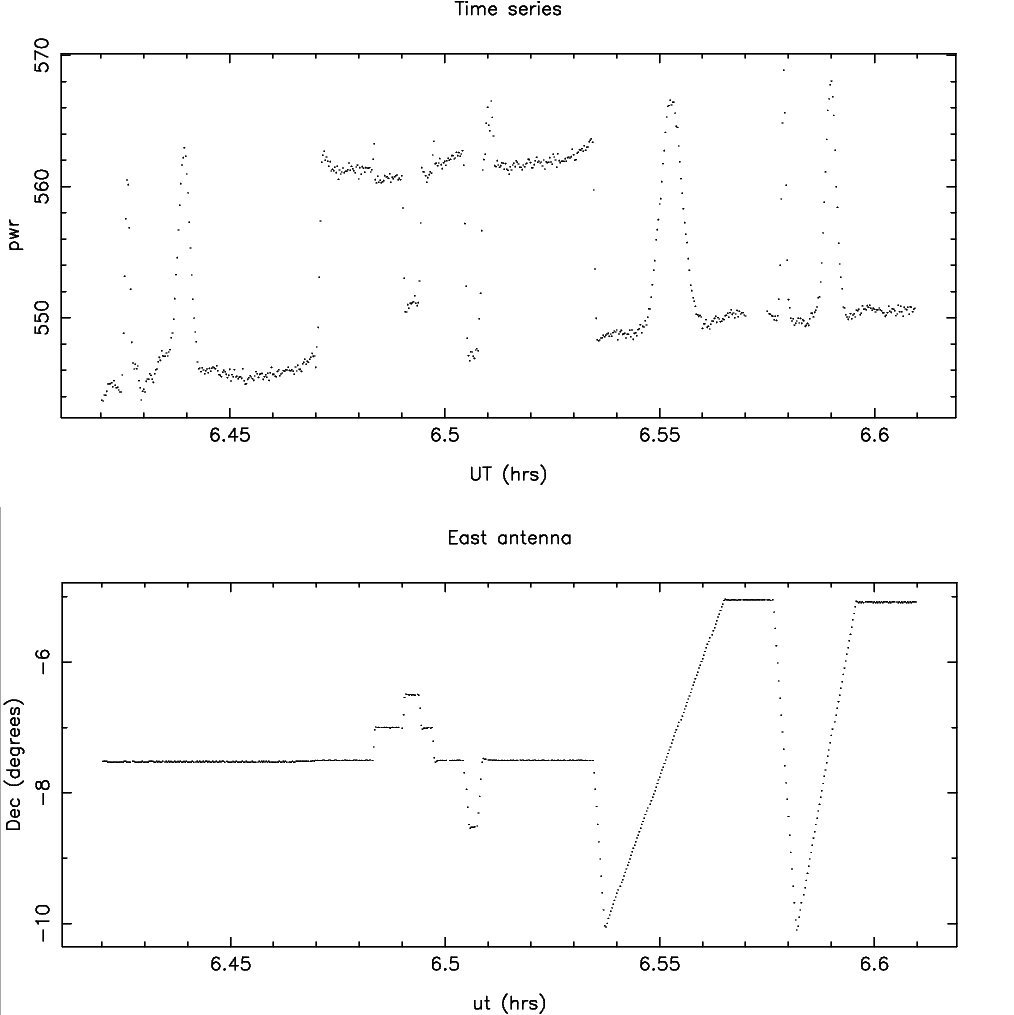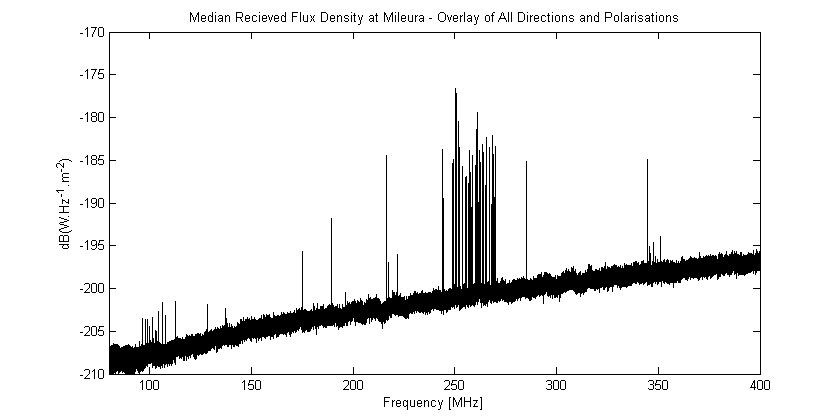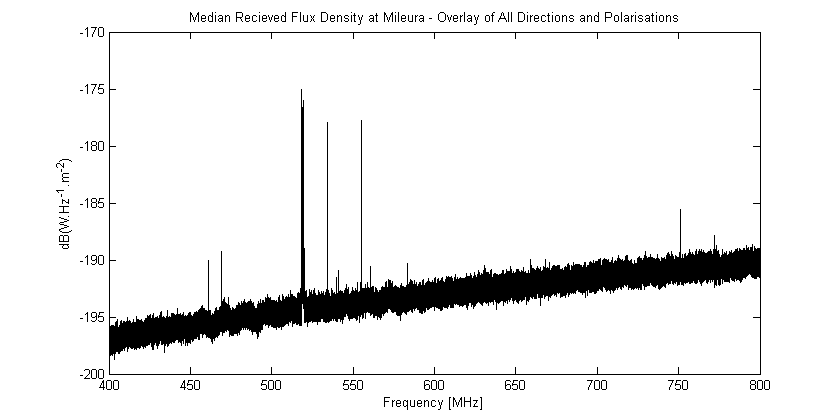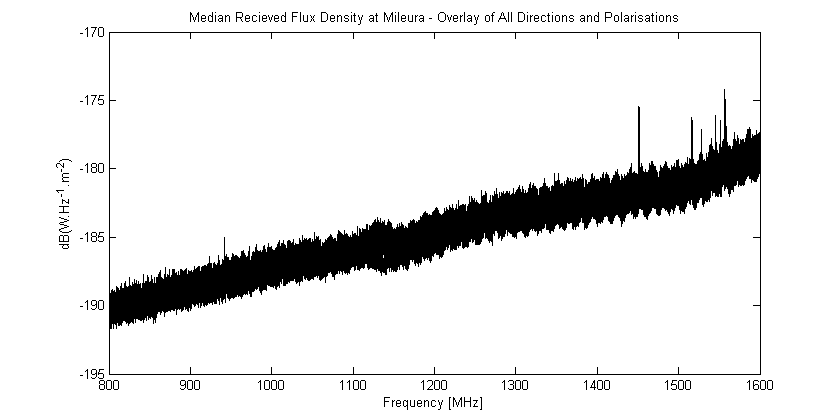SKA and xNTD news
First light for NTD antenna
On the afternoon of Friday 21 April 2006, the eastern New Technology Demonstrator (NTD) antenna on the Marsfield antenna range saw its "first light", successfully detecting the Orion Nebula.
Over the past few months the antennas have been assembled and a new reflector surface (6 mm × 6 mm mesh) installed. The original gear trains were retained, but new drive and control systems were needed. The eastern antenna now has a simple L-shaped receiver in the primary focus. An uncooled low-noise amplifier (LNA) sends the signal from a single feed to the antenna's pedestal, where it is mixed down to a few tens of megahertz in two stages. Initial tests were performed using the unmodulated beacon of a geo-stationary satellite, Optus B1, with a transmitter positioned on the grass near the antenna. The Orion Nebula was then successfully detected with cross-scans, using approximately 10 MHz of bandwidth (Figure 1).
Figure 1: The upper panel shows the power measured at the conversion chain output as a function of time, and the lower panel shows the antenna offset in declination at the same time. The Orion Nebula is clearly detected during two scans at 6.55 h and 6.59 h (click on image for larger version).
Future work includes determining the pointing model, accurately measuring the focus and measuring the far-field reception pattern of the antenna. The procedure will have to be repeated for the western antenna, before experiments can begin with a focal-plane array in one dish and a single-feed receiver in the other.
Enno Middelberg and Mike Kesteven
(Enno.Middelberg@csiro.au)
Antenna feeds
Our main tasks now in the NTD project are to fur-ther underst and the behaviour of Vivaldi feeds and develop a better design to meet the requirements of the extended New Technology Demonstrator (xNTD) and Square Kilometre Array (SKA) for high dynamic range, frequency coverage and sensitivity to polarisation. We now think that the needs of the xNTD could be better met using a feed based on a periodically loaded linear connected array. This approach would need the design of the LNA to be closely integrated with the feed design. Within the NTD project, we will develop a 5 × 5-element prototype tile that will be further developed for the xNTD.
We recently obtained our first fringes from the two-element interferometer at Marsfield. However, we have not yet mounted the THEA tile (see ATNF News, February 2006) on the East antenna, because lab testing showed that interference from the SBS analogue TV signal at 527 MHz - greater than expected - would create intermodulation problems in our passband above 1 GHz. As a result, we have had to modify the front-end circuits of the THEA by including filters and replacing a buffer amplifier. We now expect to install the THEA tile in July. Mean-while, investigations of other feed and LNA designs, led by John O'Sullivan, are progressing well.
Project management
CSIRO is moving to organise and fund its research by "theme", and from 1 July 2006 all the NTD and xNTD projects will be part of a new theme in the ATNF known as "xNTD and SKA Phase 1". The xNTD has been divided into eight projects:
xNTD System Design, Integration and Infrastructure;
NTD;
xNTD Antennas and Control;
xNTD Smart Feeds;
xNTD Digital Systems;
xNTD Receivers;
xNTD Computing; and
xNTD Signalling and Data Transport.
The Australian SKA Project Office (ASPO) project will also be incorporated into the theme.
Draft plans for this structure have been submitted to the ATNF Project Review Board (PRB) for approval, and will be finalised and discussed in detail with the PRB in mid-June.
The new theme requires some new positions: a full-time Theme Leader, a second Project Manager, four software engineers, and three engineers for the digital, receiver and data transmission projects. We have begun recruiting.
The xNTD Project Scientist, Simon Johnston, has written a discussion paper on "Science with the xNTD". This can be found at www.atnf.csiro.au/projects/ska/newdocs/xntd_science31.pdf , and we invite comments on it.
The xNTD team has been working with Michelle Storey in developing the National Collaborative Research Infrastructure Strategy (NCRIS) Radio Astronomy Investment Plan. The project plan for xNTD has been developed with the NCRIS funding in mind; strategies have been developed to deal with various possible levels of NCRIS funding.
The Low Frequency Demonstrator (LFD) has received funding from the National Science Foundation (NSF), and in the week starting 5 June some members of the xNTD team attended a meeting in San Diego to discuss the instrument's future development. Discussions included how the xNTD and LFD can best benefit and share the infrastructure needed at Mileura, and possible options for use of NCRIS funding.
The xNTD project plans cover the commissioning of the instrument and its early science. Ray Norris has been leading some preliminary discussions on this. In developing plans for commissioning we will draw on experience gained in commissioning other instruments, such as the Compact Array.
Over the past few months we have had considerable interaction with the South African and Canadian SKA teams. Tim Cornwell visited South Africa and has identified common work packages in the software development of the xNTD with the South African KAT project. Three members of the Canadian SKA team spent a week here in May, during which we identified a number of areas in which our two teams could collaborate.
Colin Jacka
(Colin.Jacka@csiro.au)
Radio frequency interference at Mileura
In March the ATNF completed an analysis of the data gathered on the radio-frequency environment at Mileura over the previous 12 months. On 10 March this was presented to the International SKA Planning Office (ISPO), in the form of a 131-page report (plus several hundred pages of appendices). The report included a characterisation of "typical" remote array stations located near Meekatharra and Moora (nearer to Perth). The remote-station measurements were conducted in January/February this year, coincident with the onslaught of several cyclones on the WA NW coast. Locals have credited us with breaking the drought!
Much of the data related to the 50 MHz to 3 GHz region of the spectrum, but smaller datasets were used to characterise the 3 - 26 GHz spectrum.
The results show that spectral occupancy is extremely low, even below 1.6 GHz, which is, internationally, the most crowded; however, the globally ubiquitous US Navy Satellite communications were always present in the 240 to 270 MHz VHF band. Some interesting propagation effects were noted below 1 GHz, such as ionospheric "sporadic E" and tropospheric ducting phenomena. Some sporadic E was from as far away as Queensland. Fortunately such events were only apparent for an hour or so in a week or longer.
Figure 2: Median received flux density at Mileura Station. The three plots above show an overlay of all directions and polarisations. The only bands with significant occupancy are the US Navy's Fleet Satellite Communications (FLTSATCOM) bands and the Digital Radio Concentrator System (DRCS) network, providing communication to local homesteads. The FM band is also labelled, although the spectrum occupancy in each 20 MHz band is indistinguishable from the system noise (click on images for larger versions).
The study was partially funded by the Government of Western Australia, under the Major National Research Facilities program.
The Australian Communications and Media Authority (ACMA) has been developing a regulatory framework for a radio-quiet zone (RQZ) to help maintain the radio-quietness of the Mileura site. The ACMA is developing coordination procedures to achieve the best possible result for radio astronomy, without unnecessarily denying radio communication services to the local community. To achieve this balance, it plans to define an inner zone, where licensing of radio communications is tightly restricted, and an outer zone, where radio communications are coordinated in such a way as to minimise interference to radio astronomy.
The ACMA has introduced a spectrum embargo for the area around the proposed SKA core site. This embargo (Embargo 41) applies to new radio communications licences within 150 km of the site for frequencies from 100 to 230 MHz, and within 100 km of the site for frequencies from 230 MHz to 25.25 GHz. It applies to licensed, coordinated terrestrial stations, and satellite ground stations. The embargo is expected to be an interim, short-term solution until detailed coordination procedures are introduced.
Ron Beresford and Diana Londish
(Ron.Beresford@csiro.au)




